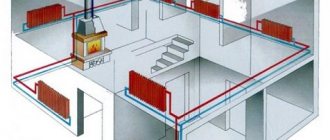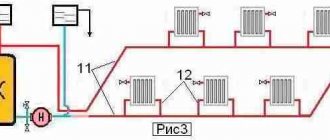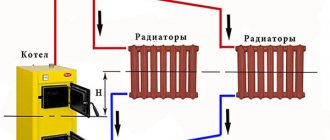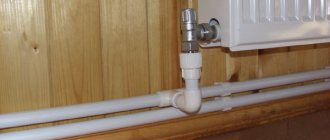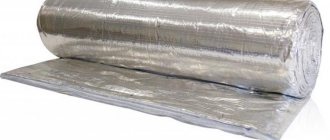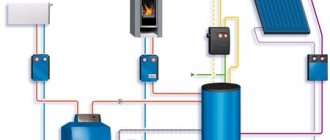What is the principle of the gravitational heating system
Gravitational heating is also called natural circulation system. It has been used for heating houses since the middle of the last century. At first, the common population did not trust this method, but seeing its safety and practicality, they gradually began to replace brick stoves with water heating.
Then, with the advent of solid fuel boilers, the need for bulky furnaces disappeared altogether. The gravitational heating system works on a simple principle. The water in the boiler heats up and its specific gravity becomes less cold. As a result, it rises along the vertical riser to the top of the system. After that, the cooling water begins its downward movement, and the more it cools down, the greater the speed of its movement. This creates a flow in the pipe towards the lowest point. This point is the return pipe installed in the boiler.
As it moves from top to bottom, the water passes through the heating radiators, leaving some of its heat in the room. The circulation pump does not participate in the movement of the coolant, making this system independent. Therefore, she is not afraid of a power outage.
The calculation of the gravitational heating system is done taking into account the heat loss of the house. The required power of the heating devices is calculated, and on this basis the boiler is selected. It should have a power reserve of one and a half times.
Description of the circuit
In order for such heating to work, the ratios of pipes, their diameters and angles of inclination must be correctly selected. In addition, some types of radiators are not used in this system.
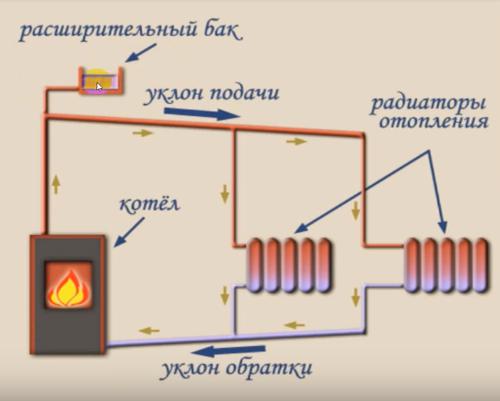
Consider what elements the entire structure consists of:
- Solid fuel boiler. The entry of water into it should be at the lowest point of the system. Theoretically, the boiler can also be electric or gas, but in practice they are not used for such systems.
- Vertical riser. Its bottom is connected to the boiler feed, and the top forks. One part is connected to the supply pipe, and the second is connected to the expansion tank.
- Expansion tank. Excess water is poured into it, which is formed during expansion from heating.
- Supply pipeline. In order for the gravitational hot water heating system to work effectively, the pipeline must have a lower slope. Its value is 1-3%. That is, for 1 meter of pipe, the difference should be 1-3 centimeters. In addition, the diameter of the pipeline should decrease with distance from the boiler. For this, pipes of different sections are used.
- Heating devices. Either large-diameter pipes or cast-iron radiators M 140 are installed as them. Modern bimetallic and aluminum radiators are not recommended to be installed. They have a small flow area. And since the pressure in the gravitational heating system is low, it is more difficult to push the coolant through such heating devices. The flow rate will decrease.
- Return pipeline. Just like the supply pipe, it has a slope that allows water to flow freely towards the boiler.
- Taps for drainage and water intake. The drain cock is installed at the lowest point, directly next to the boiler. The tap for water intake is made wherever it is convenient. Most often this is a place close to the pipeline that connects to the system.
Features of design and installation
The main nodes of the gravitational system include:
- a heating boiler in which water or antifreeze is heated;
- pipeline (double or single);
- heating batteries;
- expansion tank.
During the design, as well as directly during the installation of the system, it is very it is important to comply with one prerequisite: the pipe through which the coolant will move must be inclined towards the heating boiler. The slope should be at least 0.005 m per one linear meter of the pipe.
In general, if the boiler and radiator are located on the same floor, then the entrance to the radiator pipe should be slightly higher.
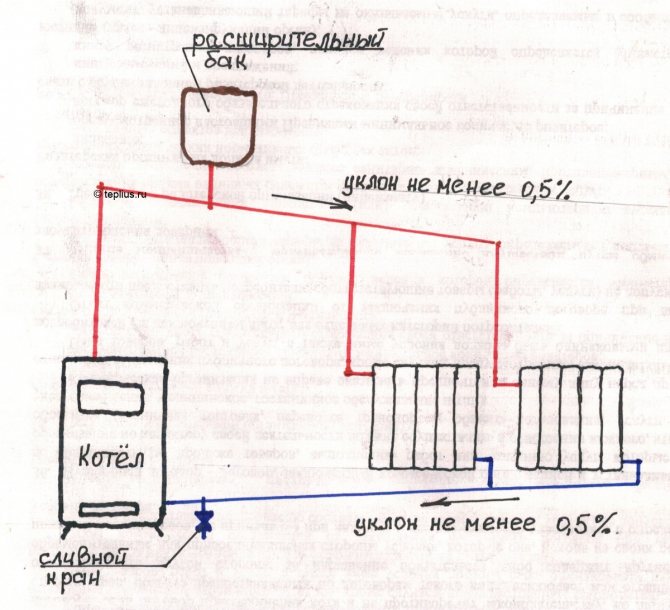

Diagram of a gravity system with a slope of pipes
The presence of this bias is explained by the following factors:
- the cold coolant will enter the boiler faster through the inclined pipe;
- the presence of a slope is also necessary in order for the air bubbles that appeared during the heating of the coolant to rise more efficiently into the expansion tank, from which they evaporate into the atmosphere.
Expansion vessel creates additional pressure, which has a beneficial effect on the speed of movement of water through pipes.
The speed of movement of the working fluid directly depends on the difference in quantities such as mass, density and volume of the coolant in the cold and hot state. The flow rate is also affected by the level of the radiators relative to the boiler.
Gravitational pressure in the heating system, it is consumed to some extent in order to overcome the resistance of the pipeline. Turns and branches in the system, additional radiators act as additional obstacles.
Therefore, in order to maximize heating of the room, when designing a gravity system, it is necessary to ensure that such obstacles are as few as possible.
disadvantages
Proponents of closed systems cite a lot of disadvantages of gravitational heating. Many of them look far-fetched, but still we list them:
- Ugly appearance. Large diameter supply pipes run under the ceiling, disrupting the aesthetics of the room.
- Difficulty in installation. Here we are talking about the fact that the supply and return pipes change their diameter stepwise depending on the number of heating devices. In addition, the gravitational heating system of a private house is made of steel pipes, and they are more difficult to install.
- Low efficiency. It is believed that closed heating is more economical, however, there are well-designed natural circulation systems that work no worse.
- Limited heating area. The gravity system works well in areas up to 200 sq. meters.
- Limited number of storeys. Such heating is not installed in houses higher than two floors.

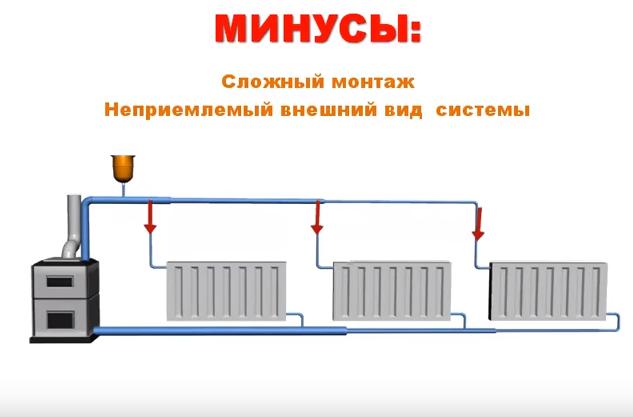
In addition to the above, gravitational heat supply has a maximum of 2 circuits, while in modern houses several circuits are often made.
The principle of circulation of the coolant in the system
If we talk about apartment buildings, then in such buildings, the circulation of water in the heating system is due to the pressure drop formed between the supply and outlet pipelines. It is absolutely logical that if the pressure in one pipe exceeds the pressure in another, then this will inevitably cause the water in the circuit to move (read: "Losses and pressure drop in the heating system - we solve the problem").
However, this is not the case with private houses. In these structures, heating systems very often operate in an autonomous mode, and the main source of energy in such systems is usually electricity, sometimes solid fuels. This option provides for the movement of water, which is carried out due to the operation of a circulation heating pump equipped with an electric motor with a small power of 100 W.
But the use of such modern equipment is far from always possible, in addition, such mechanisms appeared on the construction market relatively recently.
Previously, the main type of heat supply was the gravitational heating system, the diagram of which shows in detail the entire process of circulation of the coolant. In this case, the movement of water occurred naturally. In this case, we are talking about such a physical phenomenon as convection, when the density of the heated material decreases, and its place is taken by other, heavier substances. If this whole process burns in a confined space, then the heated material rises to the top point.
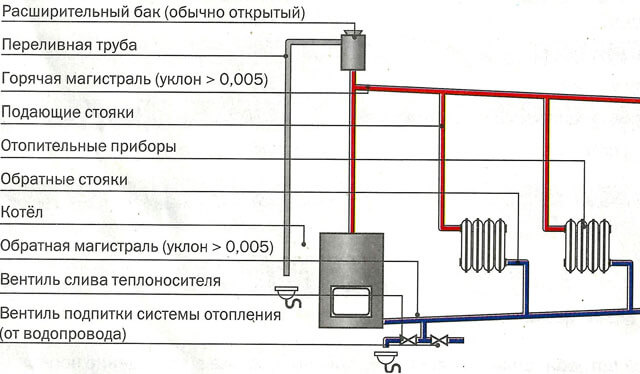

In order to use such a mechanism of operation effectively, it is required to equip a special circuit with an appropriate shape, and thanks to the principle of convection, the coolant will move in a circle continuously.
In simpler terms, the diagram of a gravitational heating system consists of two communicating vessels, which are interconnected in a ring by means of pipes, or a heating circuit. The first of these vessels is the boiler, and the second is the heating device used.
It is important to remember that the height of the heating boiler, which is equipped with an accelerating manifold for heating radiators, is directly proportional to the speed of the coolant moving inside the circuit.
The water heated by the boiler flows upward, and in its place comes colder water coming from the battery, where it gradually heats up. Then the reheated coolant again moves to the radiator, and the already cooled one enters its place. This is the essence of natural circulation, since these cycles are endless and do not require any human intervention.
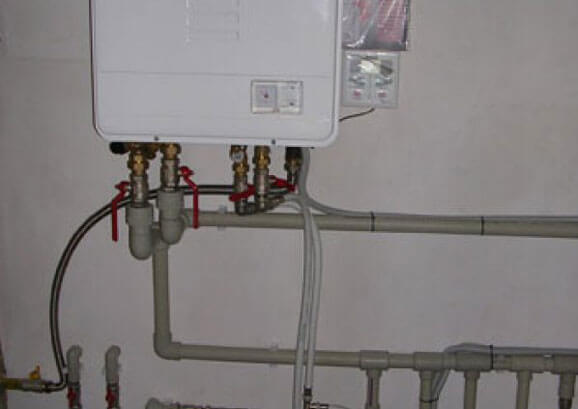

In order for such a closed gravitational heating system to have a high circulation rate of the coolant, the following points should be taken into account:
- the heating boiler must be placed as low as possible relative to the heating devices, and if there is a basement, it will be better to install it there;
- the height of the accelerating manifold can be different, this mechanism can be located both directly under the ceiling, and even higher, for example, in the attic. The heating expansion tank should also be installed in the same place (read also: "Collector heating system of a private house - wiring diagram");
- Improving the circulation of water will also allow the device of a certain slope from the tank to the boiler, since the optimal scheme of the gravitational heating system provides for the movement of cooled water according to this principle.
You should also not forget that two parameters affect the rate of circulation of the coolant in the system: this is the difference within the circuit, as well as the indicator of hydraulic resistance (about
Differences in the operation of a solid fuel boiler
The heart of any heating system is the boiler. Although it is possible to install the same models, operation with different types of heating will differ. For normal boiler operation, the temperature of the water jacket must be at least 55 ° C. If the temperature is lower, then in this case the boiler inside will be covered with tar and soot, as a result of which its efficiency will decrease. It will need to be constantly cleaned.
To prevent this from happening, in a closed system, a three-way valve is installed at the outlet of the boiler, which drives the coolant in a small circle, bypassing the heating devices, until the boiler heats up. If the temperature begins to exceed 55 ° C, then in this case the valve opens and water is added to the large circle.
A three-way valve is not required for a gravity heating system. The fact is that here the circulation does not occur due to the pump, but due to the heating of the water, and until it heats up to a high temperature, the movement does not begin. In this case, the boiler furnace remains constantly clean.The three-way valve is not required, which makes the system cheaper and simpler and adds pluses to its merits.
Technical features of the gravitational heating system
This version of the heating system device is distinguished by its nuances and has many obvious and indisputable advantages, which are customary to include the following:
- such a circulation system is able to independently regulate the work process and distribute the coolant inside the circuit exactly as the circuit requires;
- resistance to any mechanical damage, due to the strength of the circuit and the pipes used. The design does not have any quickly wearing parts, due to which the two-pipe gravitational heating system, which is a traditional one, can function properly for more than half a century without the need for any repair work;
- absolute autonomy of work, which is a very important advantage. This system does not depend on whether the electricity is on or not, which avoids various unforeseen situations;
- it is not difficult to design such heating with your own hands, since the circuit device and its scheme will be extremely clear even to an inexperienced owner. In case of difficulties, you can always study various photo and video materials that can be found from specialists who assemble and connect equipment of this type.
One way or another, the traditional gravitational heat supply system has some negative aspects, which also cannot be ignored:
- the inertial performance of this equipment will be very large. This means that it will take a very large amount of time from the moment the boiler is fired up to fully heat up;
- despite the fact that the piping is extremely simple, the cost of such equipment is quite high. The thick pipe used for installation has a very considerable price;
- in the event that the system is not connected quite correctly, then this will cause a large difference in temperature between the radiators;
- due to the fact that the water circulation rate is low, there is a potential risk of freezing the expansion tank and that part of the circuit that is located in the attic.
Heating safety
As mentioned above, the pressure in a closed system is greater than in a gravitational one. Therefore, they take a different approach to security. In closed heating, the expansion of the heating medium is compensated for in an expansion vessel with a membrane.
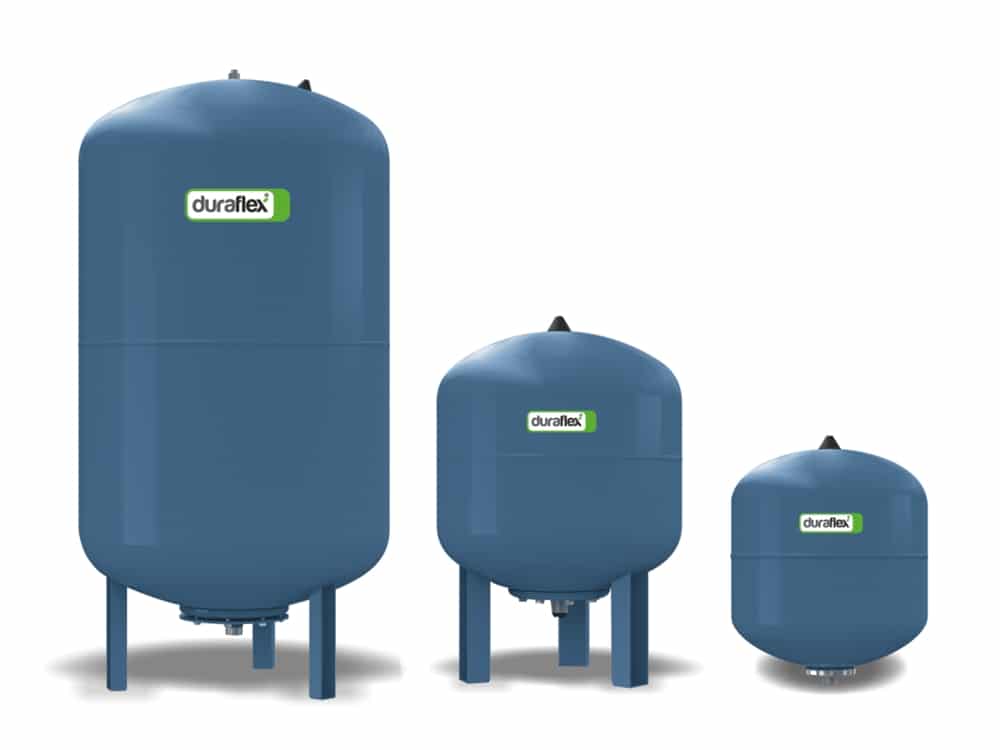

It is completely sealed and adjustable. After exceeding the maximum permissible pressure in the system, the excess coolant, overcoming the resistance of the membrane, goes into the tank.
Gravitational heating is called open because of a leaky expansion tank. You can install a membrane-type tank and make a closed gravitational heating system, but its efficiency will be much lower, because the hydraulic resistance will increase.
The volume of the expansion tank depends on the amount of water. For the calculation, its volume is taken and multiplied by the expansion coefficient, which depends on the temperature. Add 30% to the result.
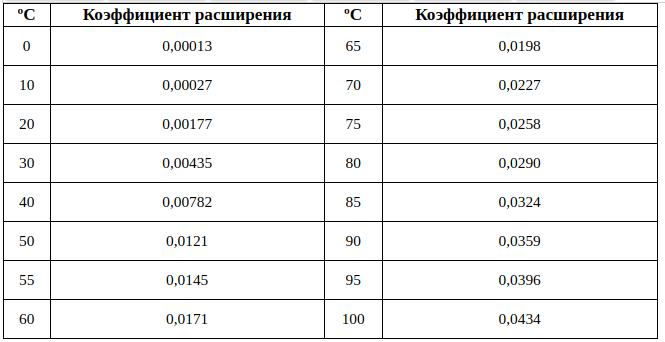

The coefficient is selected according to the maximum temperature that the water reaches.
A simplified version of the heating system with natural circulation of the heat carrier
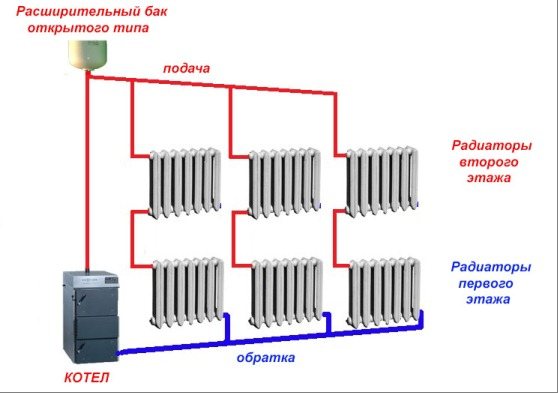

When choosing a private gravitational heating system, it is necessary to carry out a number of calculations in order to understand how the system will provide heating of the room. Under normal conditions, the volume of individual rooms and the power of heating radiators installed in them are taken into account in the layout of the piping layout. When installing radiators of the same rating, the gravitational heating system will heat up the rooms unevenly.The first radiator closest to the boiler will heat up more, and in the radiator farthest from the boiler, the coolant temperature will be significantly lower. That is why, when selecting heating devices, the former are installed with a lower power, and those that are farther must be more powerful.
It is important to choose the right expansion tank in the choice of structural elements. When calculating the volume of the expansion tank, it is customary to take the ratio 1/10 as the basis. That is, when the volume of water in the system is about 250 liters, the volume of the tank must be at least 25 liters.
The gravitational heating system is very demanding on the materials of construction. First of all, this applies to pipes and pipelines. The large volume of the coolant and the low pressure in the system require that the circulation be carried out with the lowest losses, and this is possible, either in steel or in polypropylene pipes. But here, too, there are certain limitations. So, steel pipes must be connected either by gas or electric welding, or by means of threaded connections. And if the first type allows you to provide a reliable connection practically without obtaining a weld inside the pipe, then the threaded method can create a large number of irregularities inside the pipeline. As for the polypropylene pipe, it has one significant drawback. This disadvantage concerns the ability of the pipe to withstand high temperatures - the maximum temperature that such a pipe can withstand is +95 degrees, which is not suitable for a pipe installed immediately after the boiler.
But even in spite of all these caveats, a simplified diagram of a gravitational heating system is significantly different from a forced circulation system.
Such a system must necessarily include:
- Heating boiler (a prerequisite for such systems is the presence of a boiler with a large volume of a hot water jacket);
- Large diameter water pipes 11/2 inches;
- Expansion tank with a capacity of 1/10 of the volume of liquid in the system;
- Supply pipes with a diameter of 1 inch;
- Radiators of different sizes to ensure uniform heating of the premises;
- Return pipe;
- Liquid drain cock;
- A thermometer and a pressure gauge in the boiler, and Mayevsky's taps in the radiators are installed as control devices in the system.
As you can see, the system has a small number of structural elements and is quite suitable for assembling it yourself.
Traffic jams and how to deal with them
For normal operation of heating, it is necessary that the system is completely filled with a coolant. The presence of air is strictly not allowed. It can create a blockage that prevents the passage of water. In this case, the temperature of the boiler water jacket will be very different from the temperature of the heaters. To remove air, air valves and Mayevsky taps are installed. They are installed at the top of the heaters as well as at the top of the system.
However, if the gravity heating has the correct slopes of the supply and return pipes, then no valves are required. The air in the inclined pipeline will freely rise to the top point of the system, and there, as you know, there is an open expansion tank. It also adds the advantage of open heating by cutting down on unnecessary elements.
Is it possible to mount a system of polypropylene pipes
People who make heating on their own often think about whether it is possible to make a gravitational heating system from polypropylene. After all, plastic pipes are easier to install. There are no expensive welding jobs and no steel pipes, and polypropylene can withstand high temperatures. You can answer that such heating will work. At least for a while. Then the efficiency will start to decline.What is the reason? The point is in the slopes of the supply and outlet pipes, which ensure the gravity of water.
Polypropylene has greater linear expansion than steel pipe. After repeated cycles of heating with hot water, the plastic pipes will begin to sag, breaking the required slope. As a result of this, the flow rate, if not stopped, will significantly decrease, and you will have to think about installing a circulation pump.
Difficulties in installing a gravity system in a two-story house
The gravity heating system of a two-story house can also work efficiently. But its installation is much more difficult than for a one-story one. This is due to the fact that roofs of the attic type are not always made. If the second floor is an attic, then the question arises: what to do with the expansion tank, because it should be at the very top?
The second problem that will have to be faced is that the windows of the first and second floors are not always on the same axis, therefore, the upper batteries cannot be connected to the lower ones by laying pipes in the shortest way. This means that you will have to make additional turns and bends, which will increase the hydraulic resistance in the system.
The third problem is roof curvature, which may make it difficult to maintain correct slopes.
Recommendations for this system
To improve the existing scheme, experts can suggest the following measures to increase efficiency:
- Installation of the pump. It is circulating and installed on the bypass. Its vocation is to reduce the inertia of the system. If the heating time is exceeded, the pump will help to increase the speed of the water flowing through the pipes to obtain the required temperature;
- Main slope - to achieve optimal pressure in the gravity heating system.
- Reduced bends along the entire length of the pipeline. This helps to reduce the risk of reducing the speed of the water along the line.
- Setting a reverse trap. It will prevent the possibility of water movement in the opposite direction.
Underfloor heating
To keep the floor warm, you need a manifold cut. Each circuit is connected through an individual temperature controller. This will complicate the design of the system as a whole, but will create additional comfort. In this case, it is necessary to install the supply manifold in the attic, since there, the highest point of the house, if the attic is not insulated, be sure to do it. All these measures are taken before the installation of the entire system.
Advantages and disadvantages of a gravitational heating system
Summing up, we list the main advantages that the gravitational system has:
- Reliability (since the system is made of high-strength metal and other reliable materials, repair work will have to wait for a very long time, since there are no elements that are subject to rapid deterioration);
- Lack of dependence on energy supply;
- Lack of noise and vibration;
- Ease of operation.
It would seem that there are no downsides at all, but they are, although not significant:
- At first glance, the whole system is quite simple, but this does not apply to financial investments for its acquisition. The amount will be quite large;
- Some wiring diagrams assume large temperature differences between batteries;
- If the circulation rate is low, there is a possibility that the expansion tank and part of the system located in the attic will freeze, therefore, it was previously said about its insulation.
- At the first start of the system, heating of all radiators located along the entire circuit will take several hours.
Tips for installing gravity heating in a two-story house
Most of these problems can be solved during the design phase of the house. There is also a little secret on how to increase the heating efficiency of a two-story house. It is necessary to connect the outlet pipes of the radiators installed on the second floor directly to the return pipe of the first floor, and not do the return pipe on the second.
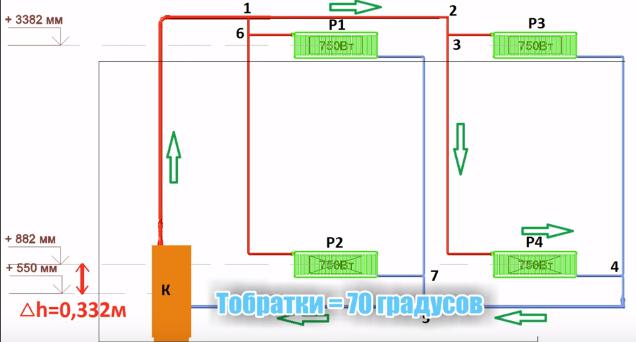

Another trick is to make the supply and return pipelines from large diameter pipes. Not less than 50 mm.
Installation
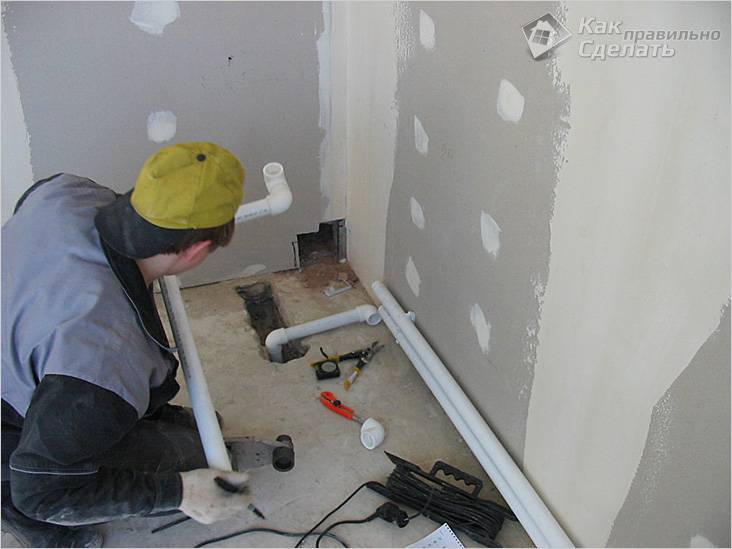

Installation of a gravity system
- As already mentioned, the boiler must be installed at the lowest point.
- Not a single pipe should be below the level of the return flow inlet to our heater. Neglecting this requirement will lead to a significant deterioration in the performance of the heating system.
- On the walls, a marking of the location of pipes and radiators is made.
- Hanging of radiators is carried out - their position is checked by the building level.
- A booster manifold is mounted from the boiler feed pipe. This must be a large diameter pipe.
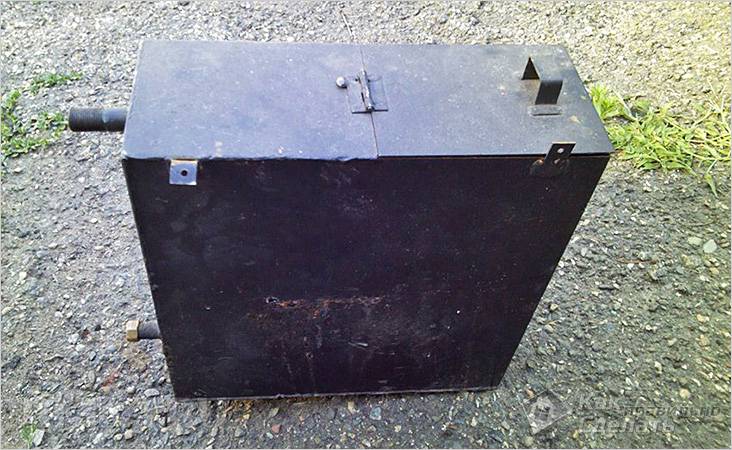

Expansion tank for home heating system
- An open expansion tank is installed at the top point. If it is in the attic, then the container and pipeline must be thoroughly insulated.
- The pipes are fastened with a slope of 1 cm per linear meter of the pipe. If it is not possible to adhere to this norm, then the difference can be reduced to 0.5 cm, but not less. It should be borne in mind that with a decrease in the slope of the pipe, the efficiency of the entire heating system decreases.
- In the right place, a pipe is cut in to the radiator. In a metal pipeline, the branch can be welded or connected through a tee. When working with plastic pipes, you need to use fittings, soldering them, not forgetting about taps and thermostats (if their installation is provided).
- At the lowest point of the system (usually near the boiler), you need to install a tap with a tap - through it, water will be poured into the system.
When planning the manufacture of a gravity system in a two-story house, you need to take into account that the coolant is supplied to the second floor, and then it goes down the risers into the radiators installed on the first floor.
It remains to fill the system with water, and, having checked it for leaks, heat the room without worrying that the electricity may be cut off.
Is a pump needed in a gravity heating system?
Sometimes an option arises when the heating was incorrectly installed, and the difference between the temperature of the boiler jacket and the return is very large. The hot coolant, not having enough pressure in the pipes, cools down before reaching the last heating devices. Redoing everything is a laborious job. How to solve the issue with minimal costs? Installation of a circulation pump in a gravitational heating system can help. For these purposes, a bypass is made, into which a low-power pump is built.
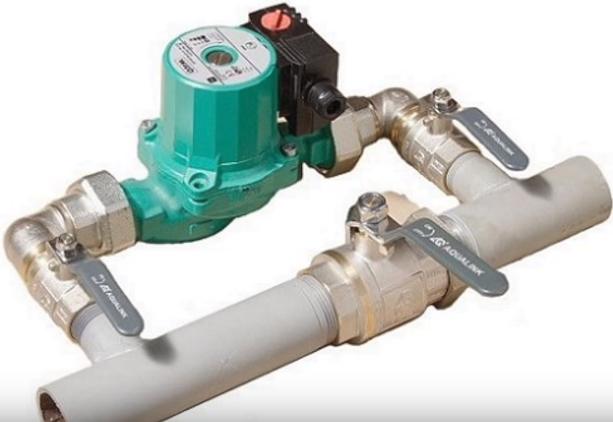

High power is not required, since with an open system, an additional head is created in the riser leaving the boiler. The bypass is needed in order to leave the possibility of working without electricity. It is installed on the return line in front of the boiler.
What to look for when designing a gravitational heating system
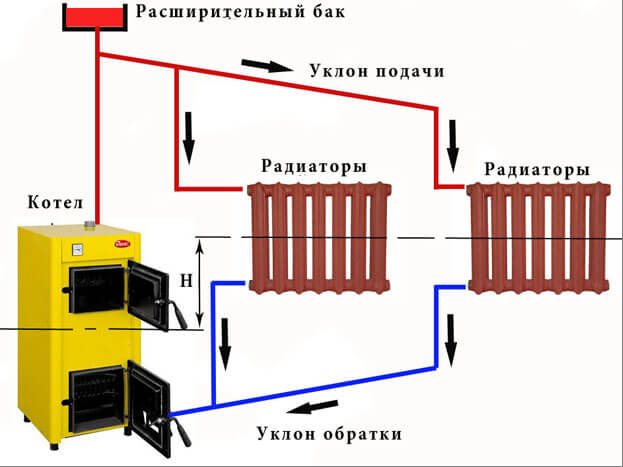

The main problem of the effective operation of the gravitational heating system in low-rise private houses is the incorrect location of the boiler and radiators relative to each other. One of the important parameters of the system is the value of the circulating head. It shows the distance from the center of the heater to the center of the boiler. The higher this indicator, the more efficient the work of the entire system.
The inefficiency and low efficiency of heating boilers, both solid fuel and gas, installed in gravitational systems are often associated with a small difference in heights between the radiator and the boiler. So, under normal conditions, this difference is usually only 0.2-0.3 meters. This situation does not allow saving up to 25% of fuel. Most of the energy is spent on superheating the liquid. At the same time, if you increase the height difference by 0.5 meters and bring it to 0.7-0.8 meters, then the efficiency will increase by 6-11%, and with a difference of 2.0 meters, it becomes possible to save up to 20% of energy ...That is why, when designing gravity-type heating systems, the boiler is planned to be placed at the lowest point, most often in the basement.
At the same time, considering all the options and methods for installing heating systems in a private house, despite the seeming simplicity of implementing this project, it is recommended to entrust it to professionals. Experience and availability of special equipment will help to ensure quick and, most importantly, easy installation of all equipment, minimizing the risk of errors.
How else to improve efficiency
It would seem that a system with natural circulation has already been brought to perfection, and it is impossible to come up with anything that increases efficiency, but this is not so. The convenience of its use can be significantly improved by increasing the time between boiler furnaces. To do this, you need to install a boiler with a higher power than is required for heating, and remove the excess heat into a heat accumulator.
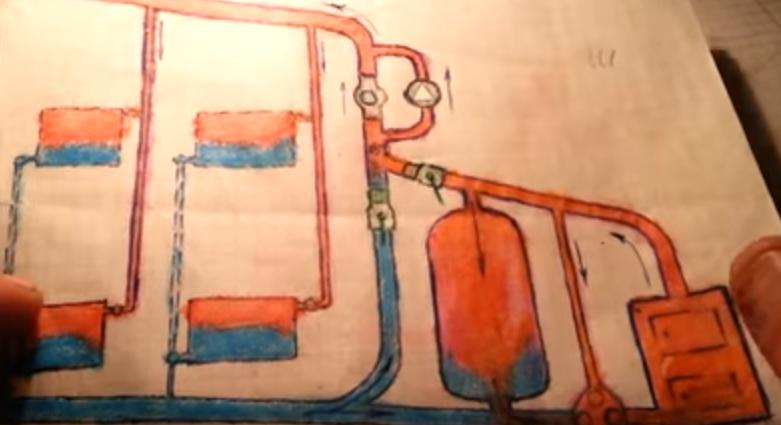

This method works even without using a circulation pump. After all, the hot coolant can also rise up the riser from the heat accumulator, at a time when the firewood in the boiler burned out.
